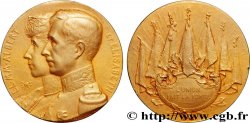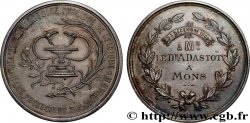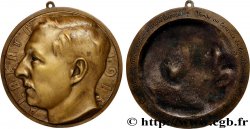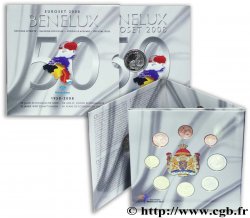Live auction - fme_816388 - BELGIEN - KÖNIGREICH BELGIEN - ALBERT I. Médaille, Exposition Universelle de Bruxelles
Sie müssen angeschlossen sein und von cgb.fr genehmigt werden, um in einer E-Auktion teilzunehmen.Melden Sie sich an, um zu wetten..Die Kontobestätigungen sind innerhalb von 48 Stunden nach Ihrer Anmeldung gemacht.Warten Sie nicht bis die letzten zwei Tage vor dem Abschluss eines Verkaufs, um Ihre Registrierung abzuschließen. Klickend "BIETEN" verpflichten Sie sich vertraglich, diesen Artikel zu kaufen und Sie nehmen ohne Reserve die allgemeinen Verkaufsbedingungen für den live auctions zu cgb.fr an.
Der Verkauf wird an der Zeit auf der Übersichtsseite angezeigt geschlossen werden. Angebote, die nach der Schließung Zeit empfangen sind, werden nicht gültig.
Bitte beachten Sie, dass die Fristen für die Einreichung Ihres Angebots auf unsere Server können variieren und es kann zur Ablehnung Ihres Angebots entstehen, wenn es in den letzten Sekunden des Verkaufs gesendet wird. Die Angebote sollen mit ganzer Zahl ausgeführt sein, Sie können Kommas oder des Punktes in Ihrem Angebot nicht erfassen. Bei Fragen klicken Sie hier, um einen Blick auf die FAQ Live-Auktionen.
Alle Gewinngebote unterliegen einem Aufschlag von 18 % für Verkaufskosten.
Alle Gewinngebote unterliegen einem Aufschlag von 18 % für Verkaufskosten.
| Schätzung : | 70 € |
| Preis : | 35 € |
| Höchstgebot : | 35 € |
| Verkaufsende : | 24 Juni 2025 15:05:10 |
| Bieter : | 1 Bieter |
Type : Médaille, Exposition Universelle de Bruxelles
Datum: 1910
Name der Münzstätte / Stadt : Belgique, Bruxelles
Metall : Bronze
Durchmesser : 70 mm
Stempelstellung : 12 h.
Graveur DEVREESE Godefroid (1861- 1941)
Gewicht : 131,41 g.
Rand lisse
Punze : sans poinçon
Kommentare zum Erhaltungszustand:
Patine hétérogène avec des taches noires et des marques d’usure
Vorderseite
Titulatur der Vorderseite ROYAUME DE BELGIQUE - EXPOSITION UNIVERSELLE DE BRUXELLES 1910.
Beschreibung Vorderseite Héraut à cheval sonnant de la trompette, signé : G. DEVREESE..
Rückseite
Titulatur der Rückseite À L’EXERGUE : 1910.
Beschreibung Rückseite Renommée tenant une palme et remettant une couronne de laurier à un artisan tenant son vase dans les bras ; l’ensemble dans un escalier au centre d’un décors gothique.
Kommentare
L'Exposition Universelle et Internationale, est une Exposition universelle qui s'est déroulée à Bruxelles du 23 avril au 1er novembre 1910. C'est la troisième exposition internationale de la ville. L'exposition est relativement généraliste mettant en avant les réalisations industrielles, commerciales et coloniales de la Belgique.
Elle eut un grand succès et reçut la visite de près de 13 millions de visiteurs, sur près de 90 hectares et près de 29 000 exposants.
L'Exposition se déroula au plateau du Solbosch à Bruxelles, et à Tervuren où fut organisée une Exposition coloniale. Sur le site du Solbosch se trouvait également un village pittoresque Bruxelles-Kermesse, conçue par les architectes Jules Barbier puis Franz Van Ophem comme une reconstitution d'un Bruxelles de jadis qui était déjà en train de disparaître.
L'exposition a pour particularité d'avoir la présence pour la première fois pour ce type d'évènement de pavillon nationaux notamment du Royaume-Uni ou de l'Allemagne, bien que plus diffuse la présence de représentant français est très important avec près de 45 000 m² de bâti qu'il lui sont consacré.
L'Exposition de 1910 s'est dramatiquement interrompue à la suite d'un terrible incendie qui a éclaté dans la nuit du 14 au 15 août 1910 qui en a entièrement ravagé le grand palais central, Bruxelles Kermesse, ainsi que le pavillon britannique et des stands français..
The Universal and International Exhibition was a World's Fair that took place in Brussels from April 23 to November 1, 1910.. This is the city's third international exhibition.. The exhibition is relatively general, highlighting Belgium's industrial, commercial and colonial achievements..
It was a great success and received the visit of nearly 13 million visitors, over nearly 90 hectares and nearly 29,000 exhibitors..
The Exhibition took place at the Solbosch plateau in Brussels, and in Tervuren where a Colonial Exhibition was organized.. On the Solbosch site there was also a picturesque village, Brussels-Kermesse, designed by the architects Jules Barbier and then Franz Van Ophem as a reconstruction of a Brussels of yesteryear that was already disappearing..
The exhibition has the particularity of having the presence for the first time for this type of event of national pavilions notably from the United Kingdom and Germany, although more diffuse the presence of French representatives is very important with nearly 45,000 m² of buildings dedicated to it..
The 1910 Exposition was dramatically interrupted following a terrible fire that broke out during the night of 14 to 15 August 1910, completely destroying the large central palace, Brussels Kermesse, as well as the British pavilion and French stands..
Elle eut un grand succès et reçut la visite de près de 13 millions de visiteurs, sur près de 90 hectares et près de 29 000 exposants.
L'Exposition se déroula au plateau du Solbosch à Bruxelles, et à Tervuren où fut organisée une Exposition coloniale. Sur le site du Solbosch se trouvait également un village pittoresque Bruxelles-Kermesse, conçue par les architectes Jules Barbier puis Franz Van Ophem comme une reconstitution d'un Bruxelles de jadis qui était déjà en train de disparaître.
L'exposition a pour particularité d'avoir la présence pour la première fois pour ce type d'évènement de pavillon nationaux notamment du Royaume-Uni ou de l'Allemagne, bien que plus diffuse la présence de représentant français est très important avec près de 45 000 m² de bâti qu'il lui sont consacré.
L'Exposition de 1910 s'est dramatiquement interrompue à la suite d'un terrible incendie qui a éclaté dans la nuit du 14 au 15 août 1910 qui en a entièrement ravagé le grand palais central, Bruxelles Kermesse, ainsi que le pavillon britannique et des stands français..
The Universal and International Exhibition was a World's Fair that took place in Brussels from April 23 to November 1, 1910.. This is the city's third international exhibition.. The exhibition is relatively general, highlighting Belgium's industrial, commercial and colonial achievements..
It was a great success and received the visit of nearly 13 million visitors, over nearly 90 hectares and nearly 29,000 exhibitors..
The Exhibition took place at the Solbosch plateau in Brussels, and in Tervuren where a Colonial Exhibition was organized.. On the Solbosch site there was also a picturesque village, Brussels-Kermesse, designed by the architects Jules Barbier and then Franz Van Ophem as a reconstruction of a Brussels of yesteryear that was already disappearing..
The exhibition has the particularity of having the presence for the first time for this type of event of national pavilions notably from the United Kingdom and Germany, although more diffuse the presence of French representatives is very important with nearly 45,000 m² of buildings dedicated to it..
The 1910 Exposition was dramatically interrupted following a terrible fire that broke out during the night of 14 to 15 August 1910, completely destroying the large central palace, Brussels Kermesse, as well as the British pavilion and French stands..








 Berichten über einen Fehler
Berichten über einen Fehler Die Seite drucken
Die Seite drucken Teilen meiner Auswahl
Teilen meiner Auswahl Stellen Sie eine Frage
Stellen Sie eine Frage Einlieferung/Verkauf
Einlieferung/Verkauf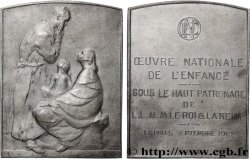
 Details
Details